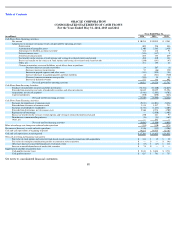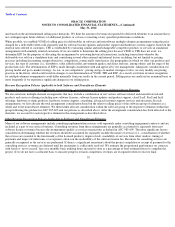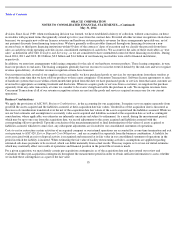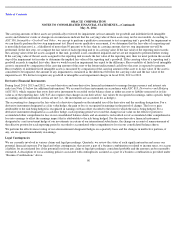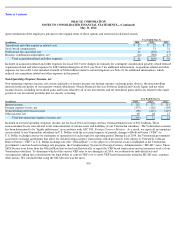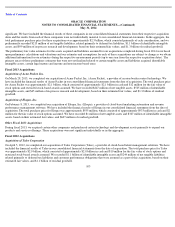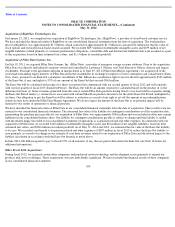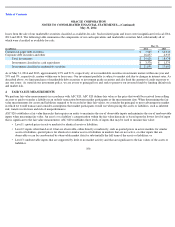Oracle 2013 Annual Report Download - page 101
Download and view the complete annual report
Please find page 101 of the 2013 Oracle annual report below. You can navigate through the pages in the report by either clicking on the pages listed below, or by using the keyword search tool below to find specific information within the annual report.
Table of Contents
ORACLE CORPORATION
NOTES TO CONSOLIDATED FINANCIAL STATEMENTS—(Continued)
May 31, 2014
Concentrations of Credit Risk
Financial instruments that are potentially subject to concentrations of credit risk consist primarily of cash and cash equivalents, marketable
securities and trade receivables. Our cash and cash equivalents are generally held with large, diverse financial institutions worldwide to reduce
the amount of exposure to any single financial institution. Investment policies have been implemented that limit purchases of marketable debt
securities to investment grade securities. We generally do not require collateral to secure accounts receivable. The risk with respect to trade
receivables is mitigated by credit evaluations we perform on our customers, the short duration of our payment terms for the significant majority
of our customer contracts and by the diversification of our customer base. No single customer accounted for 10% or more of our total revenues
in fiscal 2014, 2013 or 2012.
Inventories
Inventories are stated at the lower of cost or market value. Cost is computed using standard cost, which approximates actual cost, on a first-in,
first-out basis. We evaluate our ending inventories for estimated excess quantities and obsolescence. This evaluation includes analysis of sales
levels by product and projections of future demand within specific time horizons (generally six to nine months). Inventories in excess of future
demand are written down and charged to hardware systems products expenses. In addition, we assess the impact of changing technology to our
inventories and we write down inventories that are considered obsolete. At the point of loss recognition, a new, lower-cost basis for that
inventory is established, and subsequent changes in facts and circumstances do not result in the restoration or increase in that newly established
cost basis.
Other Receivables
Other receivables represent value-added tax and sales tax receivables associated with the sale of our products and services to third parties. Other
receivables are included in prepaid expenses and other current assets in our consolidated balance sheets and totaled $906 million and $826
million at May 31, 2014 and 2013, respectively.
Deferred Sales Commissions
We defer sales commission expenses associated with our cloud SaaS, PaaS and IaaS offerings, and recognize the related expenses over the non-
cancelable term of the related contracts, which are typically one to three years. Amortization of deferred sales commissions is included as a
component of sales and marketing expense in our consolidated statements of operations.
Property, Plant and Equipment
Property, plant and equipment are stated at the lower of cost or realizable value, net of accumulated depreciation. Depreciation is computed
using the straight-line method based on estimated useful lives of the assets, which range from one to fifty years. Leasehold improvements are
amortized over the lesser of the estimated useful lives of the improvements or the lease terms, as appropriate. Property, plant and equipment are
periodically reviewed for impairment whenever events or changes in circumstances indicate that the carrying amount of an asset may not be
recoverable. We did not recognize any significant property impairment charges in fiscal 2014, 2013 or 2012.
Goodwill, Intangible Assets and Impairment Assessments
Goodwill represents the excess of the purchase price in a business combination over the fair value of net tangible and intangible assets acquired.
Intangible assets that are not considered to have an indefinite useful life are amortized over their useful lives, which generally range from one to
ten years. Each period we evaluate the estimated remaining useful lives of purchased intangible assets and whether events or changes in
circumstances warrant a revision to the remaining periods of amortization.
97



